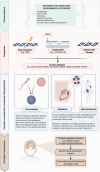Environmental exposures associated with elevated risk for autism spectrum disorder may augment the burden of deleterious de novo mutations among probands
- PMID: 34002022
- PMCID: PMC8960415
- DOI: 10.1038/s41380-021-01142-w
Environmental exposures associated with elevated risk for autism spectrum disorder may augment the burden of deleterious de novo mutations among probands
Abstract
Although the full aetiology of autism spectrum disorder (ASD) is unknown, familial and twin studies demonstrate high heritability of 60-90%, indicating a predominant role of genetics in the development of the disorder. The genetic architecture of ASD consists of a complex array of rare and common variants of all classes of genetic variation usually acting additively to augment individual risk. The relative contribution of heredity in ASD persists despite selective pressures against the classic autistic phenotype; a phenomenon thought to be explained, in part, by the incidence of spontaneous (or de novo) mutations. Notably, environmental exposures attributed as salient risk factors for ASD may play a causal role in the emergence of deleterious de novo variations, with several ASD-associated agents having significant mutagenic potential. To explore this hypothesis, this review article assesses published epidemiological data with evidence derived from assays of mutagenicity, both in vivo and in vitro, to determine the likely role such agents may play in augmenting the genetic liability in ASD. Broadly, these exposures were observed to elicit genomic alterations through one or a combination of: (1) direct interaction with genetic material; (2) impaired DNA repair; or (3) oxidative DNA damage. However, the direct contribution of these factors to the ASD phenotype cannot be determined without further analysis. The development of comprehensive prospective birth cohorts in combination with genome sequencing is essential to forming a causal, mechanistic account of de novo mutations in ASD that links exposure, genotypic alterations, and phenotypic consequences.
© 2021. The Author(s).
Conflict of interest statement
The authors declare no competing interests.
Figures


References
-
- American Psychiatric Association. Diagnostic and Statistical Manual of Mental Disorders (DSM-5). American Psychiatric Association Publishing: Washington, DC, 2013.
-
- Baxter AJ, Brugha TS, Erskine HE, Scheurer RW, Vos T, Scott JG. The epidemiology and global burden of autism spectrum disorders. Psychol Med. 2015;45:601–13. - PubMed
Publication types
MeSH terms
LinkOut - more resources
Full Text Sources
Other Literature Sources
Medical

